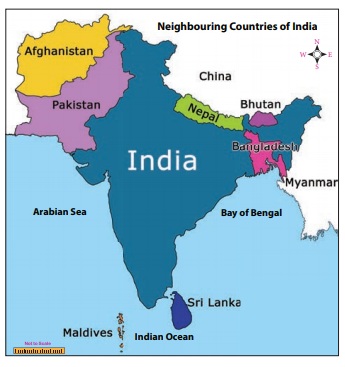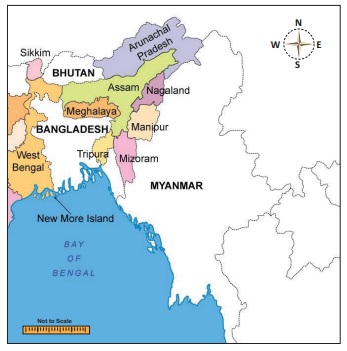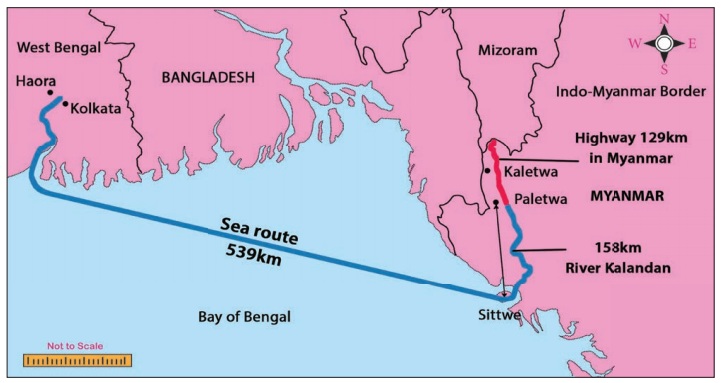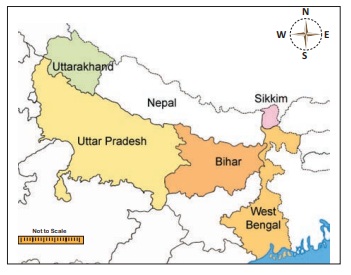India’s International Relations - India and Its Neighbours | 10th Social Science : Civics : Chapter 5 : India’s International Relations
Chapter: 10th Social Science : Civics : Chapter 5 : India’s International Relations
India and Its Neighbours
India and Its Neighbours
India’s
position is unique in its neighbourhood. India’s neighbours had been a part of
a homogenous culture prevailing in the Indian subcontinent for last five
thousand years.
• India is
a vast country with Pakistan and Afghanistan to the north-west
• China,
Nepal, Bhutan to the north
• Bangladesh
to the east
• Myanmar
to the far east
• Sri Lanka
(from south-east) and Maldives (from south- west) are two countries that lie
close to India separated by the Indian Ocean. India has cordial historical,
religious, economic, ethnic and linguistic relationship with all of these
countries. Let us know about India’s relations with its neighbours.

The countries that share the most number of neighbours touching
its borders are China and Russia.
India and Afghanistan
Indo-Afghan
relation was strengthened by the Strategic Partnership Agreement (SPA). SPA
provides assistance to re-build Afghan’s infrastructure, institutions,
agriculture, water, education, health and providing duty-free access to the
Indian market. India helped Afghans in the construction of Salma Dam in the
Herat Province. India announced 500 scholarships for the children of the
martyrs of Afghan Security Forces in school and colleges both in Afghanistan
and in India. India is also supporting Afghanistan to improve its public health
and small-scale industries. India is at the forefront of the promotion of
investment in Afghanistan and a consortium of public and private Indian
companies has been selected to make one of the biggest investments in the
mining sector. To harness India’s sports potential, India has built Kandahar
International Cricket Stadium. India’s Self Employed Women’s Association
imparts training on sustainable livelihood and to be self-reliant. Thus India
is contributing proactively to the development of Afghanistan in the form of
monetary aids and funds.
From the Indus Civilisation, India and Afghanistan have a
deep-rooted multi-faceted relationship. During the reign of Kanishka, a large
number of Indian missionaries went to China, Central Asia and Afghanistan to
preach their religion.
Khan Abdul Ghaffar Khan of Baluchistan (a border province in
today’s Pakistan) was a prominent leader of the Indian Independence movement
and active supporter of the Indian National Congress.
India and Bangladesh
India was
the first nation to acknowledge Bangladesh (the former East Pakistan) as an
independent country. India and Bangladesh share the longest land boundary of
4096.7 kilometres. India has plans to implement the proposed rail connectivity
between Agartala (India) and Akhaura (Bangladesh). Bangladesh has granted India
road transit facility through its territories from Kolkata to Agartala via
Dhaka under BBIN-MVA (Bangladesh, Bhutan, India, Nepal Motor Vehicle
Agreement). The Farakka accord on sharing of Ganga waters signed in 1977 is a
historic agreement. India and Bangladesh share 54 common rivers and a bilateral
Joint River Commission is working to maximise benefits from common river
systems. The Government of India provides grant assistance for project under
‘Aid to Bangladesh’ for the construction of buildings, laboratories,
dispensaries and deep tube wells. In addition, scholarships are granted by ICCR
(Indian Council for Cultural Relations) every year to students from Bangladesh
and it has initiated a Tagore Chair in University of Dhaka. Both the countries
jointly inaugurated the construction of 130-kilometre Bangladesh India
Friendship Pipeline between Siliguri in West Bengal and Parbatipur
(Bangladesh).
The Teen Bigha Corridor is a strip of land belonging to India on
the West Bengal– Bangladesh border, which was leased to Bangladesh in 2011.

India and Bhutan
Bhutan, a
small Himalayan kingdom, popularly known as a land of thunderbolt, is one of
the poorest countries of the world. The diplomatic relations between India and
Bhutan were established in 1968 with the appointments of a resident
representative of India in Thimphu. Bhutan is a landlocked nation. So it is
highly dependent on India for access to sea. India is the principal contributor
in the economic development of Bhutan. India declared the bilateral trade
relation known as ‘Bharat to Bhutan’ (B2B). India provides scholarship to
Bhutanese students to study in prestigious institutions of higher learning and
offered help in setting up a digital library in Bhutan. The prestigious
Nehru-Wangchuk Scholarship is being awarded to deserving and talented Bhutanese
nationals to undertake studies in selected premier Indian educational
institutions. The hydel power sector represents one of the main indicators of
bilateral co-operation between India and Bhutan. So far, Government of India
has constructed three hydroelectric projects in Bhutan (Chukha, Kurichchu and
Tala). India has helped Bhutan in developing that country’s infrastructure by
establishing telecommunication and in the construction of hospitals, roads and
bridges.
Gur Padmasambhava, a Buddhist saint who went to Bhutan from
India, played an influential role in spreading Buddhism and cementing
traditional ties between people of both nations.
India and China
In terms
of geographic and demographic dimension, skilled manpower and civilisational
depth, China is the only country in the region which qualifies for comparison
with India. China, being the manufacturing hub of the world, is strategically
very important to India. India and China share similarity of view on many
fronts like World Trade Organisation, international climate change talks and
reforms of the World Bank. Shanghai Cooperation Organisation, which was China’s
initiative, has granted the observer status to India, while SAARC had granted
the observer status to China. Both sides have established more dialogue
mechanisms covering diverse sectors. Bilateral trade has registered enormous
growth. India and China have signed an educational exchange programme. Under
this agreement, scholarships are awarded to 25 students, by both sides, in
recognised institutions of higher learning in each other’s country.
McMahon Line: This is the boundary line between India and China,
east of Bhutan. It was determined 1914 at a conference of representatives of
British India, Tibet and China. The Secretary of State for India (in British
Cabinet), Arthur Henry McMahon, represented British India at the Conference.
India and Maldives
Maldives
is located south of Lakshadweep Islands in the Indian Ocean. The relationship
with Maldives is important for India given its strategic location and
geographical proximity. India and Maldives share ethnic, linguistic, cultural,
religious and commercial links steeped in antiquity and enjoy cordial and
multi-dimensional relations. Trade and tourism are being developed between the
two countries. Both countries have agreed to strengthen cooperation to enhance
maritime security in the Indian Ocean Region through coordinated patrolling and
aerial surveillance and exchange of information.
India and Myanmar
India’s
second largest border is shared with Myanmar (known as Burma till 1989). Four
North-Eastern Indian states – Arunachala Pradesh, Nagaland, Manipur and Mizoram
– also share their borders with Myanmar. Myanmar is India’s gateway to South
East Asia. India is building the Kaladan Multi-Model Transit Transport, a
road-river-port cargo transport project to link Kolkata to Sittwe in Myanmar. A
project aiming to connect Kolkata with Ho Chi Minh City on the South Sea for
the formation of an economic zone will have a road pass through Myanmar,
Cambodia and Vietnam and work on the first phase connecting Guwahati with
Mandalay is currently underway. Myanmar is an important partner in our energy
needs for petroleum and natural gas. Some of the Indian companies such as
Essar, GAIL and ONGC Videsh Ltd. have invested in Myanmar’s energy sector.

India and Nepal
Nepal is
a natural buffer between India and China. Being a small landlocked country,
Nepal depends on India for economic support and transit facilities. India
shares borders in five indian states – – Sikkim, West Bengal, Bihar, Uttar
Pradesh and Uttarakhand – with Nepal. People residing in the border districts
on both sides share deeper cultural bonds. Indian firms are the biggest
investors in Nepal. India provides substantial financial and technical
development assistance with the focus on infrastructure, irrigation, health,
energy projects and community development. India built the 204-kilometre long
Mahendra Raj Marg to link Kathmandu and India. Nepal is endowed with
fast-flowing rivers and its terrain is ideal for hydroelectric power
generation. India has taken up the work of 5600 MW Pancheshwar project, which
remained stalled for 18 years after agreement. Nepali and Indian people visit
each other’s country for religious pilgrimage. Pashupati and Janakpur are
traditional centres in Nepal whereas Varanasi and the four Dhaams (Badrinath,
Puri, Dwaraka and Rameshwaram) are important pilgrimage destinations in India.
The bond of friendship further increased when India included Nepalese language
in the VIII schedule of the Constitution.

A joint hydropower project is being built on the Sharda River. This power plant helps both India and Nepal with respect to electricity production and irrigation facilities. From the environmental perspective, there are a number of tiger reserves along Indo-Nepal border. The governments of India and Nepal have signed three sister-city agreements for twinning of Kathmandu-Varanasi, Lumbini-Bodhgaya and Janakpur-Ayodhya.
India and Pakistan
Since the
bifurcation of territory, which demarcated India and Pakistan in 1947, the two
nations have had strained relations due to disagreements over a number of key
issues. Terrorism remains our core concern in the relationship with Pakistan.
Pakistan has been antagonistic when maintaining relations with India. But India
has made extreme efforts to improve and stabilise relations with Pakistan. The
cross-border firing between India and Pakistan and the terrorist attacks
combined have taken its toll on the Kashmiris, who have suffered poor living
standards and an erosion of human rights. Kashmir is the bone of contention between
India and Pakistan, which has brought the two countries into an open clash many
times. Cross-border terrorism is a major irritant. India tried to bring a
positive change in the relationship of the two countries through bilateral
agreements such as Shimla Agreement and Lahore Declaration.
LoC (Line of Control) The Ceasefire line determined in 1949 was
called the LoC after 1972. This is the boundary that came to be agreed between
India and Pakistan under the Shimla Agreement of 1972. It was called Radcliffe
Line at the time of partition in1947, (Radcliffe was the chairman of the border
commission.) This is now called LoC
India and Sri Lanka
India has
cultural, historical and religious ties with Sri Lanka. Separated by the narrow
expanse of the Palk Strait, India and Sri Lanka have shared excellent trade
relations committing to each other in both bilateral free trade agreements as
well as developing interactions through SAARC. The relationship between India
and Sri Lanka can generally be termed as friendly, except for the brief spell
in which the Tamil ethnic problem cast its shadow on the relations between the
two countries. India and Sri Lanka has conventionally close to each other.
India is among the top investors in Sri Lanka and its investments are in
diverse areas including petroleum retail, IT, real estate, telecommunication
and tourism. On the other hand, the Sri Lankan investments in India include
Brandix (garment city in Vishakhapatnam), MAS Holdings, John Keels, Hayleys,
apart from the other investments in the freight servicing and logistic sector.
India offers scholarship slots annually to deserving Sri Lankan students. Sri
Lanka is also a partner in Nalanda University Project of India.
Ashoka had sent his son Mahinda and daughter Sangamitra to Ceylon
(Sri Lanka) for the propagation of Buddhism. Chola kings Rajaraja I and
Rajendra I conquered the northern part of Ceylon.
Related Topics